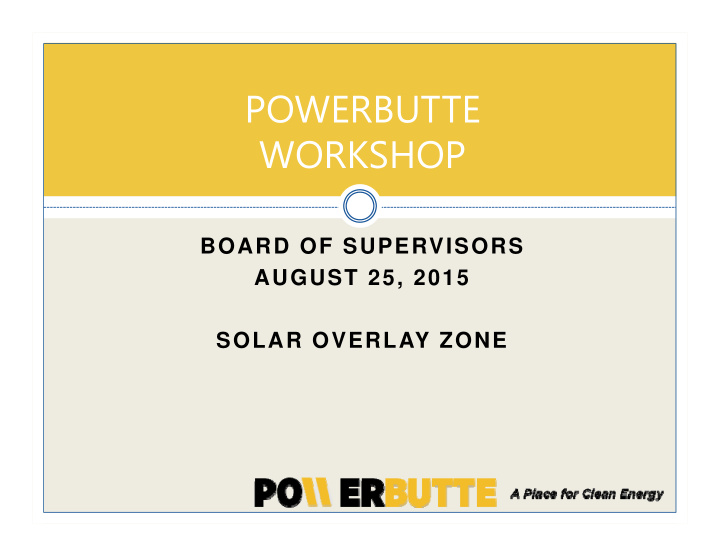



POWERBUTTE WORKSHOP BOARD OF SUPERVISORS AUGUST 25, 2015 SOLAR OVERLAY ZONE
Power Butte: Solar Over lay A Plac e F or Cle an E ne r gy hamim Mohamed
o Introduction Presentation o Context Overview o Solar Overlay Goals and Process o Vision and Guiding Principles
Introduction
Introduction 100 MW near Ontario, Canada
Introduction PGE 27 MW near city of Lemoore, CA
Introduction 88 MW south of Sacramento, CA
Introduction 5 MW atop San Francisco water reservoir
California Renewable Portfolio Standard Achieve 33% of State energy from renewables by 2020 o Vision/Goal from Governor Brown: 12,000 megawatts (MW) by o 2020 1 MW = power to 250 ‐ 500 homes o 1 MW requires 4–8 acres (or about 3–6 football fields) o 12,000 MW x 6 acres = 72,000 acres o or 48,000 new football fields Statewide 1 Ac r e
Emerging Trends Evolving electrical grid o Distributed power generation o Power flowing both ways o Vehicles and residential batteries store power o Increased local generation, control over, and responsibility o for power generation and consumption
Lessons Learned – Other Counties o Key public concerns: aesthetics/glare, environmental impacts, agricultural impacts, land use compatibility, property values, obsolescence/disposal o Strategies: site design standards and mitigations, development regulations, education/outreach o Community goals: economy/jobs, setting a good example, energy independence, regulations that mitigate impacts, streamlined permitting benefits
Lessons Learned – Other Counties A Few Facts: Kern County: Permitted 9,182 MW of renewable energy o countywide (City, Water District, schools) with rooftop, distributed generation (DG) and utility scale wind and solar Of the 9,182 MW – 4,950 MW is solar of all types o Right now, Kern has another 3 solar projects going to the o Planning Commission (total 700 MW)
Renewable Energy in Butte County Jan. 2011 ‐ May 2015: 1,725 solar permits (over $65M value) o 832 permits issued for rooftop solar last year o Butte College: Aspires to be first grid ‐ neutral o college in the US
Goals of the Solar Overlay Maximize benefits to Butte County residents o Identify optimal locations for renewable energy generation o Minimize potential impacts and conflicts o Protect natural resources and prime farmland o Provide clarity and efficiency o Streamline permitting and approval o Contribute to statewide goals o Implement the General Plan and o CAP, which mandate PowerButte
Benefits of the Solar Overlay How will the overlay benefit Butte County residents? Promotes renewable energy alternatives and reduces o dependence on fossil fuels Diversifies local electrical grid o Eliminates red tape and cuts costs for solar energy o Plans ahead to avoid impacts from o new energy infrastructure Supports local green jobs o Lowers electricity costs with o increased supply (statewide) Others? o
Solar Overlay Policy Background PowerButte Components: Solar Overlay Zone o Community Choice o Energy (CCE) Property Assessed Clean o Energy (PACE) Program Rooftop Solar o CAP monitoring and o implementation
Solar Overlay Process Task 1: Gather Data o Task 2: Create a Vision o Task 3: Analyze Data o Task 4: Explore Concepts o Task 5: Draft the Overlay o Task 6: Conduct Environmental Review o Task 7: Revise and Adopt Overlay o
Gathering Data Exclude areas that are not o appropriate for utility ‐ scale solar Identify areas that are o advantageous Evaluate opportunities and o constraints through GIS analysis Filter analysis results based o on community input to reflect community priorities
Public Involvement o Community Workshops o Stakeholder Group o Online input: buttecounty.granicusideas.com o Planning Commission o Board of Supervisors
Creating the Vision o Community Workshop #1 • Oroville: June 10, 2015 • Chico: June 11, 2015 • About 50 participants o PowerButte online survey • buttecounty.granicusideas.com • Over 60 responses to date o Planning Commission Meeting: July 30, 2015
Workshop Questions and Online Survey What benefits of solar energy are most important to you? 1. What potential negative impacts of solar energy are of greatest 2. concern? What impacts should be studied before granting a permit? a. How can impacts be minimized? b. Where are the most appropriate places in Butte County for new 3. solar energy installations? What places should be avoided? How can solar installations preserve compatibility with agricultural 4. operations?
Public Feedback Benefits: o Lower utility bills • Clean/renewable energy • Concerns: o Aesthetic impacts • Impacts to agricultural and biological resources • Reduced property values nearby • Mitigation Approaches: o Design to minimize visibility • Focus on areas already impacted • Appropriate regulations, standards, and permit • processes
Public Feedback Places to Target for Overlay: o Areas not suitable for agriculture or development • Existing structures (e.g. rooftops and parking lots) • Disturbed/impacted land • Near energy infrastructure • Area between Highways 70 and 99, near PG&E facility • Places to Avoid: o Agricultural, biological, and scenic resource areas • Near residences • Compatibility with Agriculture: o Solar shade structures for cattle • Avoid sensitive agriculture areas •
Draft Vision Butte County is a place for clean, abundant, and renewable energy supported by technological innovation. Energy generated within the county contributes to economic development, environmental protection, reduced dependence on fossil fuels, and lower greenhouse gas emissions. Locally ‐ produced clean energy also supports an affordable and reliable power network for local residences, businesses and agricultural operations as well as throughout the state. Utility ‐ scale solar facility development complements the County’s scenic qualities, avoids impacts to agricultural resources, and is sited and designed in harmony with Butte County’s communities, residential neighborhoods, and cities.
Draft Guiding Principles o Open and Transparent o Permit Streamlining Process o Utilities Coordination o Agriculture o Impact Assessment o Biological Resources o Residential Neighborhoods o Scenic Quality o Technological o Property Owner Requirements Coordination o Stakeholder Cooperation o Local Preferences o Land Use Planning o Broadly Shared Benefits
Recommend
More recommend